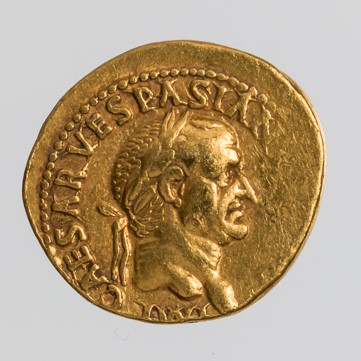Title: Aureus of Vespasian - 2015.01
Acquisition number: 2015.01
Author or editor: Hugh Preston
Culture or period: Roman Imperial
Date: AD 71
Material: Metal - Gold
Object type: Coins - Roman
Dimensions: 20mm (w)
Origin region or location: France
Origin city: Lugdunum
Display case or on loan: 7
Keywords: Coin, Aureus, Roman, Imperial, Vespasian, Aequitas, Lugdunum, Roman Gaul
Mattingly, H., E.A. Sydenham, C.H. Sutherland, R.A. Carson, The Roman Imperial Coinage 13 vols (London, Spink, 1923-1994) VII, Aquileia (p. 404), 85. II Part 1, 1114; Calicò, X., The Roman Aurei Catalogue 2 vols (Barcelona, 2003) 682; Mattingly, H.,Coins of the Roman Empire in the British Museum, 6 vols (London, 1965) 385-387.
2015.01
Aureus of Vespasian
7. 28 g. AD 71. Lugdunum
Purchased by the Friends of the ANU Classics Museum from the fund established in memory of Jill Greenwell.
Obv.: Laureate head of Vespasian, r., with legend IMP CAESARVESPASIANV[SAVG.
Rev.: Aequitas standing l. with scales and rod (pertica). TR PO[T COS] III
The portraiture of Galba, Vitellius and Vespasian (AD 69-79) marked a distinct change from the Julio-Claudian imagery. This head of Vespasian in particular marks a return to a more veristic style which no doubt suited the politics of the day. He is depicted as a military leader. Diana Kleiner , Roman Sculpture (New Haven, 1992), 172 notes that the study of his portraiture has been refined by the identification of heads (in the round) that are reworked sculptures of Vitellius and Nero. Some of the early coin heads were based on these – clearly not this one.
Coinage struck during Vespasian’s reign includes a considerable variety of reverse types. Some of these make political statements while others recall the imagery of earlier times.
Gold coins of this period have a very high purity. The Lugdunum mint produced coins in all metals in the years AD 70-72 (and base metal issues again in AD 77-78). Gold and silver from the Lugdunum mint in AD 71 differ in detail from the Rome mint issues. The reverse legend TR POT COS III only appears on one Lugdunum mint issue – that of this coin.
The numismatics of the Flavian era have been extensively revised. The Mattingly & Sydenham 1926 edition of Roman Imperial Coinage vol. II (Vespasian to Hadrian) has been partially replaced. RIC II Part 1 (2007, Carradice and Buttrey) covers the Flavian period in greater detail and incorporates up to date research.
On the purity of gold in this period, see R. Duncan-Jones (Cambridge, 1994), 215.
Mattingly, H., E.A. Sydenham, C.H. Sutherland, R.A. Carson, The Roman Imperial Coinage 13 vols (London, Spink, 1923-1994) VII, Aquileia (p. 404), 85. II Part 1, 1114; Calicò, X., The Roman Aurei Catalogue 2 vols (Barcelona, 2003) 682; Mattingly, H.,Coins of the Roman Empire in the British Museum, 6 vols (London, 1965) 385-387.

![Rev.: Aequitas standing left with scales and rod (pertica), TR PO[T COS] III](/files/artifacts/gallery/2025/6/2015.01%252520Rev.jpg)